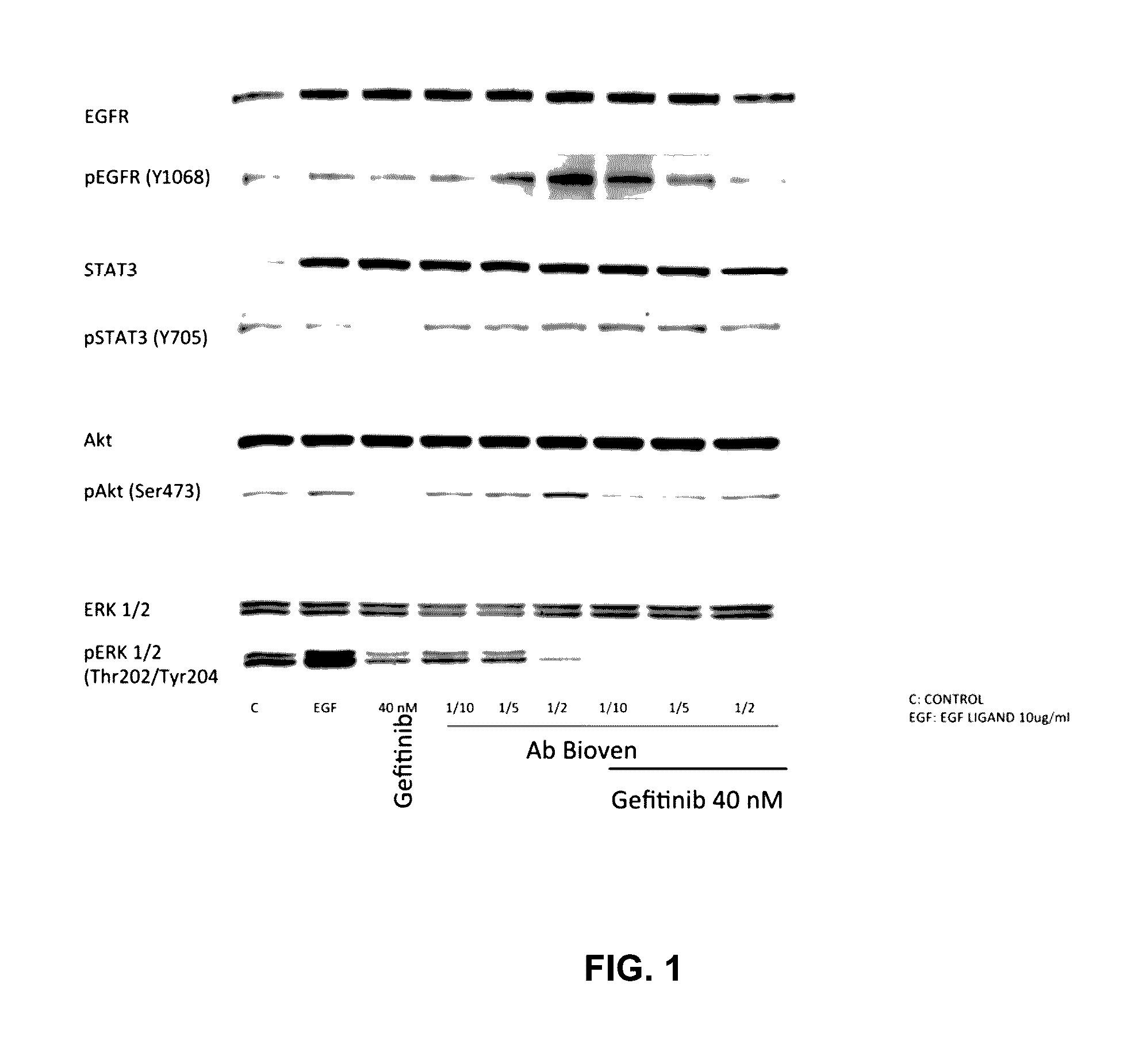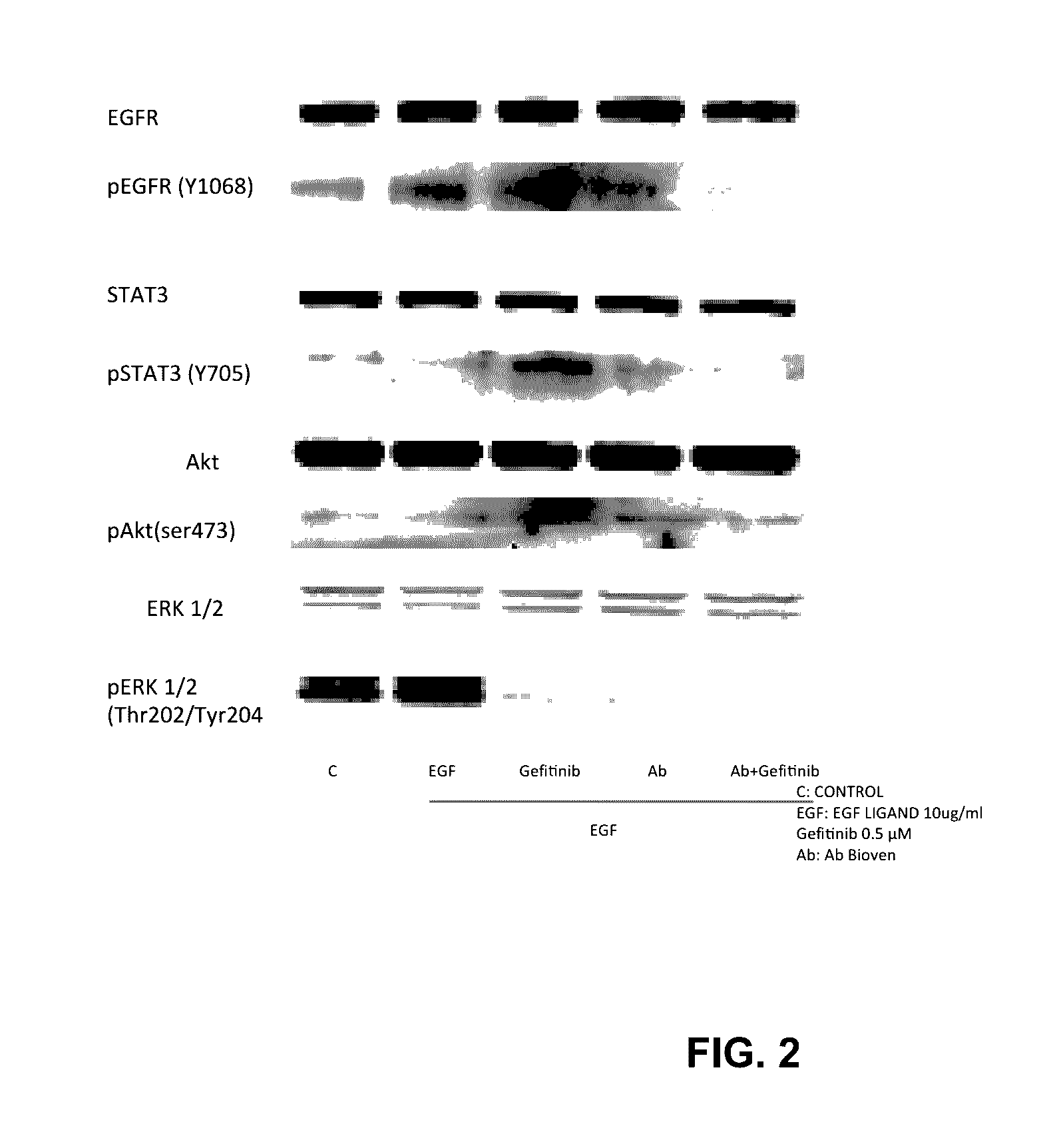Methods and compositions for inhibition of egf/egfr pathway in combination with tyrosine kinase inhibitors
a technology of tyrosine kinase inhibitor and composition, which is applied in the direction of antibody ingredients, immunoglobulins against growth factors, and cancer antigen ingredients, etc., can solve the problems of poor outcome, unsatisfactory current chemotherapy, and troubling prognosis for the majority of patients diagnosed with cancer
- Summary
- Abstract
- Description
- Claims
- Application Information
AI Technical Summary
Benefits of technology
Problems solved by technology
Method used
Image
Examples
examples
[0096]This invention is further illustrated by the following examples, which should not be construed as limiting.
example i
Assessment of Anti EGF on Inhibition of EGF / EGFR Pathway with WB as Endpoint
[0097]Objectives:
[0098]To compare, in PC9 cell line from NSCLC patients, effect of anti-EGF antibodies to Gefitinib on inhibition of the pathway activated by EGF-EGFR binding. To assess whether, in same cell line, combination of anti EGF and Gefitinib would have a synergistic effect.
[0099]Materials and Methods for Testing Activation by Western Blotting (WB) Methodology:
[0100]The PC9 cell line carries a deletion in exon 19 making this cell line sensitive to TKI's. It represents a model for the EGFR Mutated segment of the NSCLC patient cohort receiving first-line TKI treatment.
[0101]All tissue culture materials for these experiments were obtained from Biological Industries (Kibbutz Beit Haemek, Israel) or Invitrogen (Paisley, Scotland, UK). The PC9 cell line was kindly provided by F. Hoffman-La Roche Ltd (Basel, Switzerland). Cells were maintained in RPMI medium supplemented with 10% fetal bovine serum (FBS), ...
example 2
Assessment of Anti EGF (Single-Agent and Combined with Gefitinib) on Inhibition of EGF / EGFR Pathways with WB as Endpoint
[0112]A further experiment was undertaken to compare, in the PC9 NSCLC cell line, the effects of anti-EGF antibodies and gefitinib and erlotinib on the inhibition of the pathways activated by EGF-EGFR binding to assess whether, in the same cell line, the combination of anti EGF and gefitinib or erlotinib is superior to single-agent treatment. The experiment was designed to compare, in a PC9 cell line resistant to gefitinib carrying the T790M mutation (PC9-GR4), the effects of anti-EGF antibodies and TAGRISSO™ AstraZeneca (AZD9291), which is approved by the US FDA for patients with EGFR T790M mutation-positive metastatic non-small cell lung cancer, on the inhibition of the pathways activated by EGF-EGFR binding and to assess whether, in the same cell line, the combination of anti EGF and AZD9291 is superior to single-agent treatments
[0113]Materials and Methods for T...
PUM
| Property | Measurement | Unit |
|---|---|---|
| median time | aaaaa | aaaaa |
| incubation time | aaaaa | aaaaa |
| incubation time | aaaaa | aaaaa |
Abstract
Description
Claims
Application Information
 Login to View More
Login to View More - R&D
- Intellectual Property
- Life Sciences
- Materials
- Tech Scout
- Unparalleled Data Quality
- Higher Quality Content
- 60% Fewer Hallucinations
Browse by: Latest US Patents, China's latest patents, Technical Efficacy Thesaurus, Application Domain, Technology Topic, Popular Technical Reports.
© 2025 PatSnap. All rights reserved.Legal|Privacy policy|Modern Slavery Act Transparency Statement|Sitemap|About US| Contact US: help@patsnap.com



